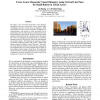Free Online Productivity Tools
i2Speak
i2Symbol
i2OCR
iTex2Img
iWeb2Print
iWeb2Shot
i2Type
iPdf2Split
iPdf2Merge
i2Bopomofo
i2Arabic
i2Style
i2Image
i2PDF
iLatex2Rtf
Sci2ools
AAAI
2010
2010
Error Aware Monocular Visual Odometry using Vertical Line Pairs for Small Robots in Urban Areas
We report a new error-aware monocular visual odometry method that only uses vertical lines, such as vertical edges of buildings and poles in urban areas as landmarks. Since vertical lines are easy to extract, insensitive to lighting conditions/shadows, and sensitive to robot movements on the ground plane, they are robust features if compared with regular point features or line features. We derive a recursive visual odometry method based on the vertical line pairs. We analyze how errors are propagated and introduced in the continuous odometry process by deriving the closed form representation of covariance matrix. We formulate the minimum variance ego-motion estimation problem and present a method that outputs weights for different vertical line pairs. The resulting visual odometry method is tested in physical experiments and compared with two existing methods that are based on point features and line features, respectively. The experiment results show that our method outperforms its t...
| Added | 29 Oct 2010 |
| Updated | 29 Oct 2010 |
| Type | Conference |
| Year | 2010 |
| Where | AAAI |
| Authors | Ji Zhang, Dezhen Song |
Comments (0)

